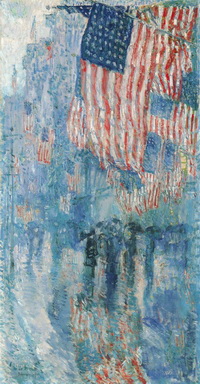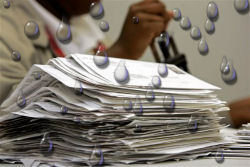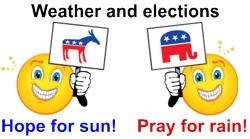
We oftentimes hear about how weather can affect voter turnout but is there truly a link? If there is, who does it benefit – Republicans or Democrats? Studies seem to indicate that what might be thought of as an urban myth is indeed true.
In 2005, political science researchers Brad Gomez, Thomas Hansford and George Krause completed the first comprehensive study on the correlation between weather and voter turnout. Their paper, “The Republicans Should Pray for Rain: Weather, Turnout, and Voting in U.S. Presidential Elections” confirmed the conventional wisdom that weather does affect voter turnout, bad weather benefits Republicans and most interestingly, two presidential elections in the last 60 years may have had different results had the weather been different.
Looking back at presidential elections from 1948 to 2008, the study takes into account the weather in 3,000 U.S. counties. They in turn looked at key areas of the nation and how weather, good and bad, affected voter turnout. In the end, the study determined that precipitation is the key weather condition to affect voter turnout.
In part, the study says:
We find that rain significantly reduces voter participation at the polls by a rate just under one percent per inch. Snowfall also decreases turnout, but only in rural counties. Moreover, we show that the estimated number of voters lost due to precipitation significantly benefits the Republican Party’s vote share and GOP incumbents particularly.
According to the study, if there was an inch of rain more than normal in a given area, nearly 1 percent fewer voters turned out and the Republican presidential candidate received an extra 2.5 percent of the vote. For every inch of snow above normal, overall voter turnout was depressed by 0.5 percent and the Republican candidate’s vote share increased by 0.6 percent.
This certainly validates the thought that Republicans “pray for rain” on election day. The authors theorize that peripheral voters – those on the fence or not dedicated, regular voters – stay home when the weather is poor. Those same “casual” voters tend to vote for the Democratic ticket when they do vote.

While the numbers certainly point to weather being a factor, is it enough to affect the outcome of an election? In most years, no, but historically there have been elections that the outcome may very well have been different had weather not impacted areas of the United States where the election was close.
In particular the study points to the elections in 1960 and 2000 as ones where different weather could very well have turned the tide to the other candidate.
In 1960 Democrat John F. Kennedy was in a tight race against Republican Richard Nixon and good weather across much of the nation may have been Nixon’s downfall. The electoral vote was one of the closest of any presidential election and Kennedy’s margin of victory in the popular vote was tremendously close – only 112,827 votes nationwide separated the two. 10 states had votes with less than a 2% difference separating the candidates and of those, poor weather in a few of them like Illinois, Missouri or New Jersey could have kept Democratic voters at home and put those states in Nixon’s column and made him President of the United States.
In 2000 a heated presidential race against Republican George W. Bush and Democrat Al Gore came down to the wire and in all, 139 electoral votes were decided by a margin of victory less than 5%. It was Florida however that held the key to who would be the next president. In the end, Bush won the state, its electoral votes and the presidency. His margin of victory in Florida was only 537 votes out of 5,922,531 ballots cast in the state – a mere 0.0092%. The weather in Florida on Election Day 2000? Rainy in many of the key counties in the state. Had the skies been clearer, analysis shows that Democratic voters may have turned out in greater numbers and thus given Al Gore the victory and the presidency.

In the end the old adage that weather impacts voter turnout and poor weather favors the Republicans turns out to be quite true.
In 2012 there are a number of toss up states that could go to Mitt Romney or Barack Obama. Today the weather in states like Colorado, Florida, Ohio, Virginia and any one of the other 10 swing states could very well determine which voters comes out to vote and ultimately who is next president of the United States.
For more info: National Weather Service

But why does bad weather have more of a negative impact on Democrats? Does that mean that the Democrats are a bunch of weather wimps?
Well, you said it – not me.
The study basically concluded that many of the “casual” voters, those less dedicated to the task, tend to vote Democrat and thus are most likely to skip voting if the weather is poor.
I wanted to respond to David’s post by stating the age of likely voters. Republicans tend to contain voters aged 30-55 and Democrats attract young voters and the seniors. Seniors simply can’t go out as often in poor weather and young people tend to not care as much.
As a response to this post (my apologies in advance for just skimming and not reading thoroughly so if this is touched upon, I am sorry) the weather will not have an impact as much on the presidential result as much as it will on the congressional votes. The Long Island district of NY (NY-1) is considered a swing district this year and the weather may hand it over to the Republican party. I suppose we will see on Tuesday.